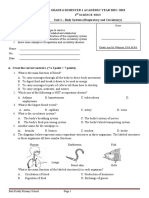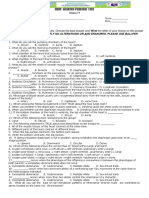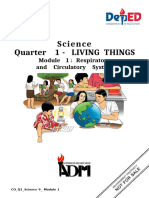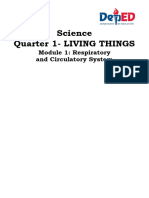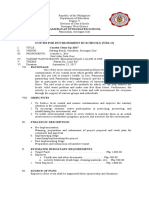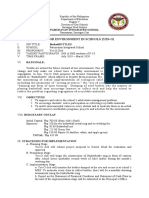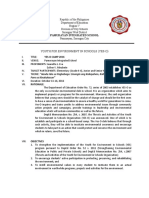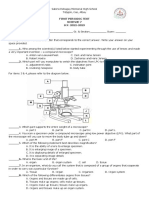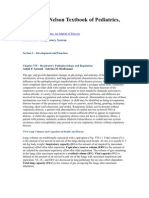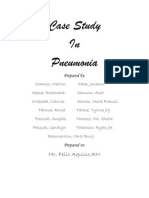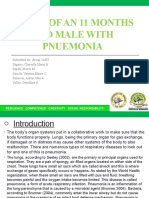Revised PT
Revised PT
Uploaded by
Rina RomanoCopyright:
Available Formats
Revised PT
Revised PT
Uploaded by
Rina RomanoCopyright
Available Formats
Share this document
Did you find this document useful?
Is this content inappropriate?
Copyright:
Available Formats
Revised PT
Revised PT
Uploaded by
Rina RomanoCopyright:
Available Formats
The roots of education are bitter, but its fruit is sweet.
-Aristotle
DEPARTMENT OF EDUCATION
Region V
Schools Division Office of Albay
SABINO REBAGAY MEMORIAL HIGH SCHOOL
Tobgon, Oas, Albay
SCORE
Periodic Examination in Science 7 :
GENERAL IN
STRUCTIONS:
Fill in necessary information before proceeding with the exam. USE BLACK INK ONLY.
An hour (60 minutes) is allotted for this exam.
60
Not following instruction would mean incorrect answer.
Do not use any scratch paper. You may use this test questionnaire for scratch work.
Strictly NO ERASURES. ERASED/ SUPERIMPOSED ANSWERS ARE CONSIDERED WRONG.
NOTE: The total number of items is 60 and the passing score is 45 (76%).
Name: Rating:
Grade & Section: Date:
Directions: Read each statement carefully. From the choices given, select the best answer by writing the letter that corresponds to your
answer on the space provided before each item. Use UPPERCASE letters only in writing your answers. (1 point each)
______ 1. Who among the scientist(s) listed below started experimenting through the use of lenses and made a very important invention
– a compound microscope?
A. Anton van Leeuwenhoek C. Zack and Hana Jansen
B. Robert Hooke D. Zacharias and Hans Jansen
______ 2. Which part will you manipulate to switch the objectives from LPO to HPO?
A. Adjustment knobs B. Revolving nosepiece C. Inclination Joint D. Body Tube
For items 3 & 4, please refer to the diagram below:
______ 3. Which part supports the entire weight of a microscope?
A. part I B. part B C. part H D. part I
______ 4. You scan a specimen under a compound microscope using low power objective (LPO). What part of the microscope will you
use to move the body tube up and down?
A. part M B. part E C. part C D. part F
______ 5. Which of the following statement best describes magnification?
A. It is the ability of a lens to enlarge specimen.
B. It is enlarging image of a specimen.
C. It is displaying details of enlarged specimen.
D. It is separating image details
______ 6. What is the basic unit of life?
A. organ B. organ system C.cell D. tissue
______ 7. In an organism, what do you call the system that is composed of a group of organs that cooperate in order to carry out a
particular function?
A. tissue B. organ C.organism D. organ system
______ 8. Which of the following differentiates organs from tissues?
A. Direction of blood flow from the heart C. Presence of oxygenated blood
B. Length of the blood vessels D. Both A and C
______ 9. These blood vessels are very small tubes which connect the arteries and the veins?
A. Arteries B. Veins C. Capillaries D. Alveoli
______ 10. Which of the following blood components is considered the NONLIVING component?
A. Red Blood Cells B. Plasma C. Platelets D. White Blood Cells
The roots of education are bitter, but its fruit is sweet.
-Aristotle
______ 11. This organ is often referred as the human pump
A. Heart B. Blood Vessels C. Stomach D. Blood
______ 12. Which of the following statements is TRUE about the human heart?
A. It is made up of four (4) chambers. C. It is located at the center of your chest.
B. It is the size of your fist. D. All of the above.
______ 13. Which of the following statements is TRUE about Pulmonary Circulation?
A. It is the blood circulation from the heart to the parts of the body except the lungs.
B. It is the blood circulation from the heart to the lungs and back to the heart.
C. It is the blood circulation from the heart to the tissues of the heart.
D. It is the blood circulation from the lungs to the heart and back to the lungs
______ 14. Which are the organs of the respiratory system?
A. Lungs, heart, and blood
B. Rib cage, diaphragm and lungs
C. Nose, lungs, heart and diaphragm
D. Lungs, throat, and passageways that lead to the lungs
______ 15. Which of the following statements about the human respiratory system is false?
A. The bronchioles branch into bronchi.
B. Alveolar ducts connect to alveolar sacs.
C. When we breathe in, air travels from the pharynx to the trachea.
E. Gas exchange between the lungs and blood takes place in the alveolus.
______21. What are the diseases acquired in respiratory system caused by cigarette smoking?
A. osteoporosis C. chronic bronchitis
B. cervical cancer and miscarriage D. Buerger’s disease
_______22. What is the disease when the harmful chemicals of cigarette damaged the bronchial tube and alveoli?
A. diabetes C. blood cancer
B. tuberculosis D. lung cancer
_______23. Which is the order of airflow during inhalation?
A. Nasal cavity, trachea, larynx, bronchi, bronchioles, alveoli.
B. Nasal cavity, larynx, trachea, bronchi, bronchioles, alveoli.
C. Nasal cavity, larynx, trachea, bronchioles, bronchi, alveoli.
D. Nasal cavity, trachea, larynx, bronchi, bronchioles, alveoli.
________24. What important activity takes place in the lungs?
A. Food is digested.
B. Liquid waste is filtered from the blood.
C. The trachea is exchanged for the larynx.
D. Oxygen is exchanged for carbon dioxide
________25. Which blood vessel carries blood back to the heart?
A. Artery B. Blood vessel C. Capillary D. Vein
________26. What type of circulation carries oxygenated blood to the body?
A. Bodily Circulation C. Pulmonary Circulation
B. Coronary Circulation D. Systemic Circulation
________27. What are some things you can do to help support your lungs health?
A. Smoking regularly C. Regular exercise and balanced diet
B. Drink alcohol excessively D. Stress all the time
________28. Which of the following will benefit our body in eating a balanced diet?
A. It improves body’s health and reduces diseases.
B. It can lead to depression.
C. We are feeling empty and stress.
D. Our body will become malnourished.
________29. How can you make good choices and stay healthy?
A. Consult health professionals when you are not feeling well.
B. Use internet to diagnose and treat yourself.
C. Buy over the counter medications.
D. Listen to anybody that gives you advices.
________30. Which one of these is NOT a disease in circulatory system?
A. Stroke B. Asthma C. Hypertension D. Heart Attack
INCOMPLETE DOMINANCE/ CODOMINANCE/ MULTIPLE ALLELES/SEX-LIMITED TRAITS
Directions: Read each statement carefully. From the choices given, select the best answer by writing the letter that corresponds to your
answer on the space provided before each item. Use UPPERCASE letters only in writing your answers. (1 point each)
_____31. Who is the Father of Genetics?
A. Albert Einstein B. Charles Darwin C. Gregor Mendel D. Isaac Newton
_____32. When a red snapdragon (RR) is crossed with a white snapdragon (rr), the offspring results with a snapdragon with pink
(Rr) flowers. This shows what type of non-Mendelian genetics?
A. Codominance B. Incomplete Dominance C. Multiple Allele D. Autosomal dominant
_____33. What does HETEROZYGOUS mean?
A. An organism that has the same genes for a trait (TT or tt)
B. An organism that has the different genes for a trait (Tt)
The roots of education are bitter, but its fruit is sweet.
-Aristotle
C. When neither gene is dominant; offspring is a mixture of both
D. The different forms of a trait (Hair color: red, brown, black, etc.)
____34. When brown cattle (BB) is crossed with a white cattle (WW), it results to a roan cattle (BW) or a cattle with both brown
and white patches. What is the genotypic ratio for this:
A. 4 BW: 0 BB: 0 WW B. 2 BW: 2 WW C. 1 BW: 3 BB D. 0 BB: 0 BW: 4: WW
____35. How many alleles control the ABO system or the blood group in humans?
A. One (1) B. Two (2) C. Three (3) D. Four (4)
_____36. Which structure in a cell are chromosomes be found?
A. cell membrane B. mitochondria C. nucleus D. centromere
_____37. Which of the following statements is TRUE about the structure of DNA?
A. The DNA is actually described as a single stranded molecule.
B. DNA is composed of a nitrogen base and phosphate only.
C. Nitrogen bases in each chain can only pair with specific base like adenine pairs only with cytosine, thymine with guanine.
D. Nitrogen base is the only part of the nucleotide that differs among the other different nucleotides.
_____38. . DNA is said to be double helix and contains deoxyribose sugar, phosphate and nitrogenous bases. If a nucleotide
sequence is encoded as CGTAGGCATAGCATC, what will be the complementary chain of the said DNA molecule?
A..GGCATAGGCTGCAAG C. GCAACGGTATCGTCG
B. GCATCCGTATCGTAG D. CGTAGGCATAGCATC
_____39. Hemophilia is an X-linked trait, why is it more commonly observed among males than in females?
A. It behaves as a recessive allele among males
B. It behaves as a dominant allele among females
C. It behaves as a recessive allele among females
D. It behaves as a sex-influenced trait among males
_____40. Why are there fewer colorblind females as compared to males?
A. Color blindness is a Y-linked trait
B. Color blindness is an X-linked trait
C. Females has one X chromosome
D. Females possess two X chromosomes
Directions: Analyze and solve the word problem below. (41-50)
(41-45) In four o’clock plants, R is the allele for red color and W is allele for white color. If the plant inherits both alleles (RW), then the
resulting offspring has pink flower. Show the possible outcome of the cross between a white four o’clock flower plant and a pink four
o’clock flower plant.
(46-50) Draw a Punnett square which shows the inheritance of the sex chromosome. Represent the female sex chromosomes with XX and
the male sex chromosomes with XY. Identify the sex of the children and the probability of having a male child and female child.
Prepared By: MISS RINA R. ROMANO
Subject Teacher
You might also like
- Test Questions With Answer Key - Science 9Document6 pagesTest Questions With Answer Key - Science 9Michael Deliva80% (15)
- MCE IGCSE Biology PPT C11 and C12Document66 pagesMCE IGCSE Biology PPT C11 and C12Aheer GhoshNo ratings yet
- Worksheet-4D - TEAM ALPHADocument4 pagesWorksheet-4D - TEAM ALPHARina Romano100% (2)
- S5 Template WAP-for-Mentors Team-Name1Document7 pagesS5 Template WAP-for-Mentors Team-Name1Rina Romano100% (4)
- DC Bio Assignment 2Document14 pagesDC Bio Assignment 2api-491445567No ratings yet
- 1st Quarter Exam 2022-2023 SCIENCE 9Document3 pages1st Quarter Exam 2022-2023 SCIENCE 9rhenz marie cadelinia german100% (14)
- Xmas Decor Contest ProposalDocument2 pagesXmas Decor Contest ProposalRina Romano100% (1)
- Sabino Rebagay Memorial High SchoolDocument3 pagesSabino Rebagay Memorial High SchoolRina RomanoNo ratings yet
- First Quarterly Test: General Biology 2Document10 pagesFirst Quarterly Test: General Biology 2glaiza abucay100% (1)
- O Level Biology Practice Questions And Answers Transport In HumanFrom EverandO Level Biology Practice Questions And Answers Transport In HumanNo ratings yet
- Respiratory System (Anatomy and Physiology)Document71 pagesRespiratory System (Anatomy and Physiology)Butch Dumdum100% (14)
- Quarter 1 Assessment SCIENCE 9Document11 pagesQuarter 1 Assessment SCIENCE 9liomer credoNo ratings yet
- 1ST QUARTER SCI Answer KeyDocument3 pages1ST QUARTER SCI Answer KeyGessel Adlaon100% (1)
- First QuarterDocument6 pagesFirst QuarterDrexel DalaygonNo ratings yet
- PRELIM Exam in Science 9Document5 pagesPRELIM Exam in Science 9Mohammad Javier D. DimaporoNo ratings yet
- Science 9 Questions 1st QuarterDocument7 pagesScience 9 Questions 1st QuarterEmely SecretarioNo ratings yet
- Q1 Periodic Test in Science 9Document4 pagesQ1 Periodic Test in Science 9Jezha Mae NelmidaNo ratings yet
- biology model grade 12Document20 pagesbiology model grade 12Yeroosan GirmaNo ratings yet
- AnhDocument15 pagesAnhduyanh4583No ratings yet
- 2nd-Quarter-Exam-in-Science-7 FINALDocument4 pages2nd-Quarter-Exam-in-Science-7 FINALMyth LiliNo ratings yet
- Science 6 Nat ReviewerDocument40 pagesScience 6 Nat ReviewerDONA FE SIADENNo ratings yet
- Summative 1 - Q2Document6 pagesSummative 1 - Q2Karen RodriguezNo ratings yet
- Sci.9 Weeks 1-2Document4 pagesSci.9 Weeks 1-2Jaime CrispinoNo ratings yet
- 2015 Health ScienceDocument15 pages2015 Health SciencePharez-david GrantNo ratings yet
- 2016 Health ScienceDocument22 pages2016 Health SciencePharez-david GrantNo ratings yet
- G-9 Summative Test 1 (WK 1-2)Document2 pagesG-9 Summative Test 1 (WK 1-2)Colleen Rubia100% (1)
- Science 9 First Quarter Exam SY 2021-2022Document5 pagesScience 9 First Quarter Exam SY 2021-2022Encluna Lindon Jay100% (1)
- Biology Assignment 2Document18 pagesBiology Assignment 2api-491537689No ratings yet
- Science Daily Test 1Document5 pagesScience Daily Test 1yuniNo ratings yet
- SUMMATIVE-TEST Science9 QUARTER-1 2023-2024Document5 pagesSUMMATIVE-TEST Science9 QUARTER-1 2023-2024Naemar Jr,No ratings yet
- 2ND Pre - Science 6Document3 pages2ND Pre - Science 6Gia Shayne DelicanaNo ratings yet
- Summative Exam Grade 5 Quarter 1Document4 pagesSummative Exam Grade 5 Quarter 1Neneth Saguin SionomioNo ratings yet
- Biology Unit Test Practice Answers Dec 2014Document4 pagesBiology Unit Test Practice Answers Dec 2014t4jr7g5mjyNo ratings yet
- 1st Quarter TestDocument4 pages1st Quarter TestMiraflor DuyoganNo ratings yet
- Grade 9 ScienceDocument4 pagesGrade 9 ScienceJocelyn AbranillaNo ratings yet
- Firsr Periodical Test in Science - Grade VIDocument7 pagesFirsr Periodical Test in Science - Grade VIDennis Reyes83% (6)
- First Quarter Periodic TestDocument2 pagesFirst Quarter Periodic TestNur ShaNo ratings yet
- St1-Science-Grade 6-Q2Document1 pageSt1-Science-Grade 6-Q2MilainNo ratings yet
- Summative Test 1 Quarter 1 Grade 9Document3 pagesSummative Test 1 Quarter 1 Grade 9Little GreenNo ratings yet
- Science 1st Quarter ExamDocument3 pagesScience 1st Quarter ExamMeanNo ratings yet
- 2nd Quarter ScienceDocument3 pages2nd Quarter Sciencesusan h. bucasasNo ratings yet
- G.science Model Exam 2 G-8Document8 pagesG.science Model Exam 2 G-8Ethiopia PrevailsNo ratings yet
- Periodical TestDocument4 pagesPeriodical TestnonononowayNo ratings yet
- Anaphy Lecture Midterm ExamDocument5 pagesAnaphy Lecture Midterm ExamBulajyo Pangngay JolinaNo ratings yet
- Q1 PT 22-23Document5 pagesQ1 PT 22-23Criselda MayoNo ratings yet
- Summative Test Science 9Document4 pagesSummative Test Science 9Erma VasayaNo ratings yet
- 2nd Quarter ExamDocument4 pages2nd Quarter ExamJewel June EstacionNo ratings yet
- Tiniguiban Elementary School First Quarterly Assessment in Science and Health Vi SCHOOL YEAR 2016-2017Document3 pagesTiniguiban Elementary School First Quarterly Assessment in Science and Health Vi SCHOOL YEAR 2016-2017Carolyn D MayugaNo ratings yet
- SCI19 - Q1 - M1 - How Do The Respiratory and The Circulatory Systems Work TogetherDocument37 pagesSCI19 - Q1 - M1 - How Do The Respiratory and The Circulatory Systems Work TogetherromeespantoNo ratings yet
- Grade 9 Long TestDocument4 pagesGrade 9 Long Testjoviealquizar13No ratings yet
- TQ_Q2_SCIENCE 7Document5 pagesTQ_Q2_SCIENCE 7MYLENE B. ZABALLERONo ratings yet
- Assignment 2 Biol1700 Mar Covid-19 Brandon WrightDocument16 pagesAssignment 2 Biol1700 Mar Covid-19 Brandon Wrightapi-508331036No ratings yet
- First Summative Test in Science 9Document2 pagesFirst Summative Test in Science 9Anna Mae A. Pamonag100% (1)
- Science 9 - Q1 - Mod1 - Respiratory and Circulatory System - VerFINALDocument35 pagesScience 9 - Q1 - Mod1 - Respiratory and Circulatory System - VerFINALJames Denzyl GadianaNo ratings yet
- Grade 9 Science Review QuizDocument5 pagesGrade 9 Science Review QuizSHEILA MAE VILLANTESNo ratings yet
- Science Grade 8 T3 Revision Mock Ans KeyDocument13 pagesScience Grade 8 T3 Revision Mock Ans Keyahmed5030 ahmed5030No ratings yet
- Human Anatomy and Physiology 1 MCQDocument57 pagesHuman Anatomy and Physiology 1 MCQsly1money9No ratings yet
- Science 9 (Done)Document4 pagesScience 9 (Done)En-en Metante SinugbohanNo ratings yet
- Science-9 Q1 Mod1 Respiratory-And-Circulatory-System VerFinalDocument32 pagesScience-9 Q1 Mod1 Respiratory-And-Circulatory-System VerFinalAshleigh MartinezNo ratings yet
- First Quarterly Exam in Science 9Document21 pagesFirst Quarterly Exam in Science 9katherine corveraNo ratings yet
- Science-9 Q1 Mod1 Respiratory-And-Circulatory-System VerFinal ANSWEREDDocument35 pagesScience-9 Q1 Mod1 Respiratory-And-Circulatory-System VerFinal ANSWEREDvonneivan26No ratings yet
- First Periodical Test in Science 6Document8 pagesFirst Periodical Test in Science 6Mayette Pamilara Payaban100% (4)
- Remedial Activity - Science-8 4TH QuarterDocument3 pagesRemedial Activity - Science-8 4TH Quartermylyn ceraficaNo ratings yet
- S6 Q2 Answer-Key-1Document7 pagesS6 Q2 Answer-Key-1rodinatahud03No ratings yet
- Biology Assignment 2 Atefah Razack 1Document15 pagesBiology Assignment 2 Atefah Razack 1api-491258706No ratings yet
- O Level Biology Practice Questions And Answers: Coordination And ResponseFrom EverandO Level Biology Practice Questions And Answers: Coordination And ResponseNo ratings yet
- Apology LetterDocument1 pageApology LetterRina RomanoNo ratings yet
- COT No. 2Document4 pagesCOT No. 2Rina RomanoNo ratings yet
- Worksheet-4B - TEAM ALPHAdocxDocument3 pagesWorksheet-4B - TEAM ALPHAdocxRina RomanoNo ratings yet
- Biodiversity SongDocument1 pageBiodiversity SongRina RomanoNo ratings yet
- Solid Waste Sanction ProposalDocument1 pageSolid Waste Sanction ProposalRina RomanoNo ratings yet
- Proposal Sdrrm-InitiativesDocument9 pagesProposal Sdrrm-InitiativesRina RomanoNo ratings yet
- Curriculum Vitae of SpeakersDocument4 pagesCurriculum Vitae of SpeakersRina RomanoNo ratings yet
- Inset 2022 2023Document8 pagesInset 2022 2023Rina Romano100% (1)
- Coastal Clean Up 2017Document2 pagesCoastal Clean Up 2017Rina RomanoNo ratings yet
- Basketbottle ProposalDocument2 pagesBasketbottle ProposalRina RomanoNo ratings yet
- For PrintingDocument5 pagesFor PrintingRina RomanoNo ratings yet
- Yes o Camp 2016Document3 pagesYes o Camp 2016Rina RomanoNo ratings yet
- 2nd PT SY 2022-2023Document12 pages2nd PT SY 2022-2023Rina RomanoNo ratings yet
- Chromosomal Mutation StoryDocument5 pagesChromosomal Mutation StoryRina RomanoNo ratings yet
- Interview For Teachers!Document16 pagesInterview For Teachers!Rina RomanoNo ratings yet
- Letter Brgy MayorDocument3 pagesLetter Brgy MayorRina RomanoNo ratings yet
- QCC BasicDocument7 pagesQCC BasicRina RomanoNo ratings yet
- Remedial Exam 2022-2023Document2 pagesRemedial Exam 2022-2023Rina Romano100% (1)
- 2022overnight Camp - ActivititesDocument8 pages2022overnight Camp - ActivititesRina RomanoNo ratings yet
- G8 PBL RtotDocument2 pagesG8 PBL RtotRina RomanoNo ratings yet
- Lesson OutlineDocument2 pagesLesson OutlineRina RomanoNo ratings yet
- Protein SynthesisDocument5 pagesProtein SynthesisRina RomanoNo ratings yet
- Investiture CeremonyDocument10 pagesInvestiture CeremonyRina Romano100% (4)
- Rina. Raise Plus. April 25-29Document5 pagesRina. Raise Plus. April 25-29Rina RomanoNo ratings yet
- Sabino Rebagay Memorial High SchoolDocument3 pagesSabino Rebagay Memorial High SchoolRina RomanoNo ratings yet
- DLL: Rina RomanoDocument6 pagesDLL: Rina RomanoRina RomanoNo ratings yet
- Chemistry ProjectDocument16 pagesChemistry ProjectSagnik DeNo ratings yet
- Grade 9 Natural Science Ls June Revision Questions 2015 CheckedDocument27 pagesGrade 9 Natural Science Ls June Revision Questions 2015 CheckedMfanafuthiNo ratings yet
- RESPIRATORY OrganDocument24 pagesRESPIRATORY OrganAnuvabNo ratings yet
- Class 10 - Science - Life ProcessesDocument14 pagesClass 10 - Science - Life ProcessesNaitik sethiaNo ratings yet
- RespiratorDocument53 pagesRespiratorlianarodicaNo ratings yet
- Human Lung DevelopmentDocument20 pagesHuman Lung DevelopmentMila KarmilaNo ratings yet
- CH 17Document20 pagesCH 17Maria BoccaNo ratings yet
- Case Study of PNEUMONIADocument19 pagesCase Study of PNEUMONIAcarls burg a. resurreccion78% (9)
- Respiratory SystemDocument11 pagesRespiratory SystemJillian Lao100% (2)
- Science 9 ActivityDocument4 pagesScience 9 ActivityKATHY CLAIRE BALLEGANo ratings yet
- Card 3Document2 pagesCard 3annaNo ratings yet
- A Level GASEOUS EXCHANGEDocument20 pagesA Level GASEOUS EXCHANGEonyangaismail12No ratings yet
- As Past Paper Questions p2Document8 pagesAs Past Paper Questions p2JanaNo ratings yet
- RESPIRATIONDocument13 pagesRESPIRATIONjasonkmensah515No ratings yet
- Chapter 8 - Respiratory SystemDocument20 pagesChapter 8 - Respiratory Systemmnurnazri10No ratings yet
- Anatomy and PhysiologyDocument87 pagesAnatomy and PhysiologyMenaka ShanthiNo ratings yet
- IB HL Biology - Paper 3 - Condensed Answers To Past Paper QuestionsDocument9 pagesIB HL Biology - Paper 3 - Condensed Answers To Past Paper QuestionsIsabella María Rosales PorrasNo ratings yet
- The Respiratory System PDFDocument25 pagesThe Respiratory System PDFbilly sauraNo ratings yet
- Ryan International Group of Institutions: Class Subject Topic: Sub TopicDocument3 pagesRyan International Group of Institutions: Class Subject Topic: Sub Topicdaksh kumarNo ratings yet
- Life Process: 1. Objective QuestionsDocument16 pagesLife Process: 1. Objective Questionsnavin gupta100% (1)
- Respiratory PhysiologyDocument33 pagesRespiratory Physiologybhagathbabu100% (2)
- Science Class X Sample Test Paper 04 For Board Exam 2020 21 AnswersDocument16 pagesScience Class X Sample Test Paper 04 For Board Exam 2020 21 AnswersAjit MoteNo ratings yet
- Atelectasis: Contraction Atelectasis (Or Cicatrization Atelectasis)Document10 pagesAtelectasis: Contraction Atelectasis (Or Cicatrization Atelectasis)Gan BangNo ratings yet
- gRAND CASEDocument69 pagesgRAND CASEYVETTE CLAIRE BORRESNo ratings yet
- Dan Emergency Oxygen Handbook v3Document73 pagesDan Emergency Oxygen Handbook v3RaphaelNo ratings yet
- CH 30 L 2 Part-1Document9 pagesCH 30 L 2 Part-1Van halenNo ratings yet
- Chapter 13 - Respiratory SystemDocument33 pagesChapter 13 - Respiratory SystemCess Abad AgcongNo ratings yet
- Cardiovascular and Respiratory SystemDocument51 pagesCardiovascular and Respiratory SystemKarel Mae SanoriaNo ratings yet




























